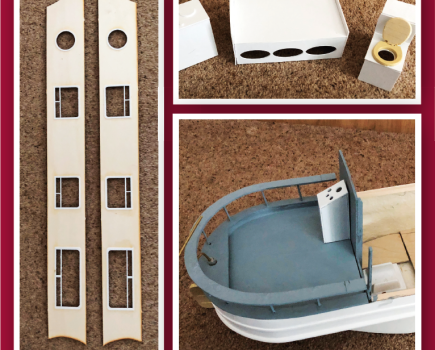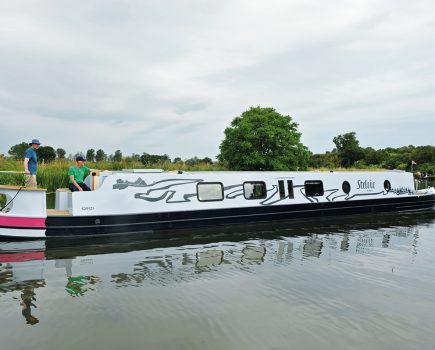In this feature we look at the process of surveying a boat, how to avoid common pitfalls and how to ensure the people you are dealing with are qualified, experienced, professionals. Giving you the ability to buy with confidence and ensure you get a great start to many years of happy boating.

Once you have decided on the boat you wish to buy, you should seriously consider having a survey done by a professional surveyor unless you have a good reason not to – which could be that you are buying a “project boat” – one that you know needs a lot of work which you are intending to do as a project. Be aware that even a brand new boat may have defects – the PDI inspection should pick things up before delivery, but even if the boat is still pretty new, consider having a survey done.
If you don’t have a survey and some faults become apparent afterwards you will potentially fall into the category of Caveat Emptor – Buyer Beware – and have no come-back. If you are buying from a dealer there will be some sort of warranty – but don’t expect this to cover returning the boat to “as new condition” if something goes wrong, particularly if the boat is some years old. Find out the terms of the warranty before you buy. Also find out by whom and where any repairs will be undertaken, as getting the boat to the repairer could be a mammoth operation, particularly if it is another country.
The broker may provide a list of local surveyors – the broker may NOT recommend a surveyor – the choice has to be yours. Call several of them and talk to each one about your requirements – get a feel for cost, availability and which surveyor you feel most comfortable with. If the broker doesn’t have a list, you can look on-line at the YDSA (Yacht Designers & Surveyors Association) website for your nearest surveyor. The YDSA was founded in 1912 and is one of the UK’s leading professional associations for surveyors. Visit www.ydsa.co.uk.
The surveyor will let you know when he can visit the boat and how long he will need approximately and ask for you to arrange the lift-out so he can view the underneath of the boat. Discuss how long he will want and then contact the yard or marina to arrange. The cost of this lift is down to you as the potential purchaser.
Generally surveyors don’t want the owner or the potential purchaser there all the time as they do need to concentrate. However, if the owner wants to be there at the beginning or the end this can be helpful to the surveyor to find out more about the boat’s history. If you do want to be there, do try to understand that the surveyor won’t want to talk to you all the time.
If there is a particular aspect of the boat that you wish to know about, tell the surveyor. He will be able to help with everything you need, or he may advise you to engage a particular specialist.
When the surveyor has finished his survey he may want to go away and think through his findings and prepare the report before he talks to you about the boat. Sometimes he needs to do some homework on things he has found to be sure of the ramifications. Sometimes the surveyor can give you an idea very quickly and occasionally one may contact you part way through the survey because of their concerns at what they have found.
Do not be worried if the surveyor goes into the broker’s office after the survey to talk about it. He may need some more information, or be trying to find out for you what leeway there may be. It can be very helpful if the broker is able to advise the vendor that the surveyor has found a particular fault, as it gives the vendor time to consider how he wants to proceed with the negotiations – he may talk to a yard about the cost of a repair and offer to have it done before the boat changes hands. However, consider that repairs done for you will have a warranty but the warranty on repairs done for the vendor will not usually carry forward. But, if the vendor has all the little things done before, that could be ideal for you.
Remember to work with the broker and the surveyor. Communication is the key to ensuring the sale completes efficiently. If you have ANY concerns over the survey don’t be afraid to discuss them with the surveyor. If there is something technical and you don’t understand the implications, do ask – it is your survey and you won’t look silly for asking.
The surveyor will give you a factual report on the condition of the vessel and advise on any items he believes need rectification or repair. He will not comment on performance for instance. He may accompany a trial and record the RPM for you but if you have questions about the performance you may need to ask a marine engineer’s advice. Or if you have queries about anything else, seek assistance from the relevant expert.
The survey should give you information on the current state of the boat – its hull, deck and equipment. It should contain recommendations on remedial action required and a timescale for these – so if something is cosmetic and can wait, this will be less serious than a hole in the bottom that needs fixing urgently! Insurers will use this list as their guide for insuring the boat, so identification of timescale is important, otherwise insurers may require everything to be done before they put insurance in place. YDSA does not like to see reams of photographs – a few which provide illustration to points in the report are perfect but photographs should not replace proper reporting of the condition of the vessel. The reporting should be clear and written in plain English – lots of technical jargon is unnecessary – ask about any terms you don’t understand.
The broker will need at least the recommendations section of the report to enable him to discuss any re-negotiation on the price, for instance, following the survey. Many brokers are very knowledgeable and it is helpful if they see the whole report so they can best represent your interests to the vendor. However, the survey should not be passed on to any other parties without the agreement of the surveyor. The survey is written for you and not for the benefit of other parties. It can, of course, be used for insurance purposes as that is for your benefit.
REGISTRATION
If you wish to register the vessel on Part 1 of the British Registry you may wish to ask the surveyor to do the tonnage survey at the same time so you can submit the papers as soon as the boat is yours and you won’t have to pay for a second visit, just the associated fees.
COMMERCIAL USE
If you want to use the boat commercially advise the broker and the surveyor. The surveyor will not do a code survey at the same time but will be able to give you an idea as to whether the boat is likely to be able to be coded or not, for the purpose and number of people you want, etc. Once you have completed the sale you will need an authorised coding surveyor to do that inspection for you. This may or may not be the same surveyor.
Image(s) provided by:
Archant







